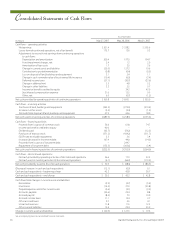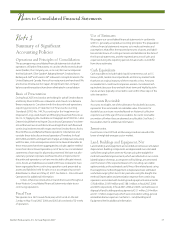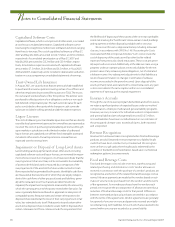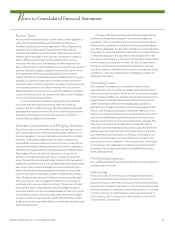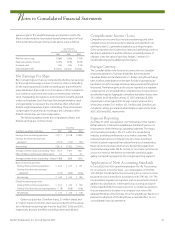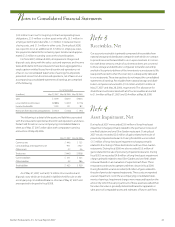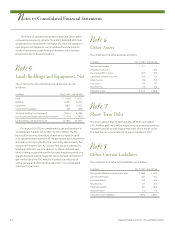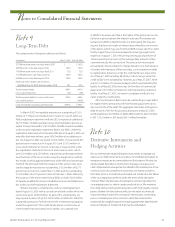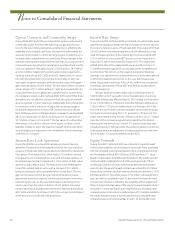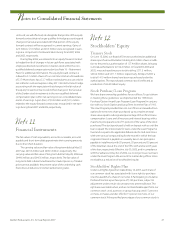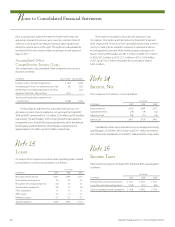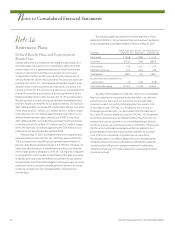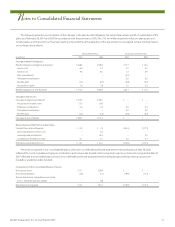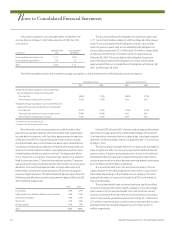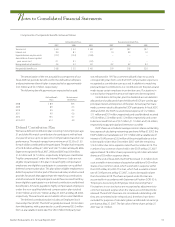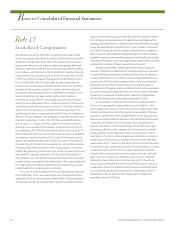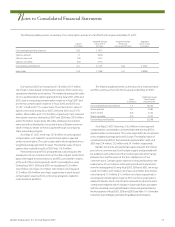Red Lobster 2007 Annual Report Download - page 47
Download and view the complete annual report
Please find page 47 of the 2007 Red Lobster annual report below. You can navigate through the pages in the report by either clicking on the pages listed below, or by using the keyword search tool below to find specific information within the annual report.
N
Darden Restaurants, Inc. Annual Report 2007 45
Notes to Consolidated Financial Statements
Note9
Long-Term Debt
The components of long-term debt are as follows:
(in millions) May 27, 2007 May 28, 2006
5.750% medium-term notes due March 2007 $ – $ 150.0
4.875% senior notes due August 2010 150.0 150.0
7.450% medium-term notes due April 2011 75.0 75.0
7.125% debentures due February 2016 100.0 100.0
6.000% senior notes due August 2035 150.0 150.0
ESOP loan with variable rate of interest
(5.645% at May 27, 2007) due December 2018 19.1 22.4
Total long-term debt 494.1 647.4
Less issuance discount (2.5) (2.8)
Total long-term debt less issuance discount 491.6 644.6
Less current portion – (149.9)
Long-term debt, excluding current portion $491.6 $ 494.7
In March 2007, we repaid at maturity our outstanding $150.0
million of 5.750 percent medium-term notes. On July 29, 2005, we
filed a registration statement with the SEC to register an additional
$475.0 million of debt securities using a shelf registration process as
well as to carry forward the $125.0 million of debt securities available
under our prior registration statement filed in July 2000. Under this
registration statement, which became effective on August 5, 2005, we
may offer, from time to time, up to $600.0 million of our debt securi-
ties. On August 12, 2005, we issued $150.0 million of unsecured 4.875
percent senior notes due in August 2010 and $150.0 million of
unsecured 6.000 percent senior notes due in August 2035 under
the registration statement. Discount and issuance costs, which
were $2.4 million and $2.9 million, respectively, are being amortized
over the terms of the senior notes using the straight-line method,
the results of which approximate those of the effective interest rate
method. The proceeds from the issuance of the senior notes were
used to repay at maturity our outstanding $150.0 million of 8.375
percent senior notes on September 15, 2005 and our outstanding
$150.0 million of 6.375 percent notes on February 1, 2006. Following
the issuance of the senior notes in fiscal 2006, we had $300.0 million
of capacity available for issuance of additional unsecured debt securi-
ties under our shelf registration statement.
We also maintain a credit facility under a Credit Agreement
dated August 16, 2005 with a consortium of banks under which we
can borrow up to $500.0 million. As part of this credit facility, we
may request issuance of up to $100.0 million in letters of credit, the
outstanding amount of which reduces the net borrowing capacity
under the agreement. The credit facility allows us to borrow at
interest rates that vary based, at our option, on a spread over
(i) LIBOR or (ii) a base rate that is the higher of the prime rate or one-
half of one percent above the federal funds rate. The interest rate
spread over LIBOR is determined by our debt rating. We may also
request that loans be made at interest rates offered by one or more
of the banks, which may vary from the LIBOR or base rate. The credit
facility supports our commercial paper borrowing program and
expires on August 15, 2010. We are required to pay a facility fee of
10 basis points per annum on the average daily amount of loan
commitments by the consortium. The amount of interest and
annual facility fee are subject to change based on our maintenance
of certain debt ratings and financial ratios, such as maximum debt
to capital ratios. Advances under the credit facility are unsecured.
As of May 27, 2007 and May 28, 2006, no borrowings under the
credit facility were outstanding. However, as of May 27, 2007, there
was $211.4 million of commercial paper which was backed by this
facility. As of May 28, 2006, there was $44.0 million of commercial
paper and $15.0 million of letters of credit outstanding under the
facility. As of May 27, 2007, we were in compliance with all cove-
nants under the credit facility.
All of our long-term debt currently outstanding is expected to
be repaid entirely at maturity with interest being paid semi-annu-
ally over the life of the debt. The aggregate maturities of long-term
debt for each of the five fiscal years subsequent to May 27, 2007,
and thereafter are $0.0 million in 2008, 2009 and 2010, $225.0 million
in 2011, $0.0 million in 2012 and $269.1 million thereafter.
Note10
Derivative Instruments and
Hedging Activities
We use interest rate-related derivative instruments to manage our
exposure on debt instruments, as well as commodities derivatives to
manage our exposure to commodity price fluctuations. We also use
equity related derivative instruments to manage our exposure on
cash compensation arrangements indexed to the market price of our
common stock. By using these instruments, we expose ourselves,
from time to time, to credit risk and market risk. Credit risk is the failure
of the counterparty to perform under the terms of the derivative
contract. When the fair value of a derivative contract is positive, the
counterparty owes us, which creates credit risk for us. We minimize
this credit risk by entering into transactions with high quality counter-
parties. Market risk is the adverse effect on the value of a financial
instrument that results from a change in interest rates, commodity
prices, or market price of our common stock. We minimize this
market risk by establishing and monitoring parameters that limit the
types and degree of market risk that may be undertaken.
Note5
Note6
Note7
Note8



